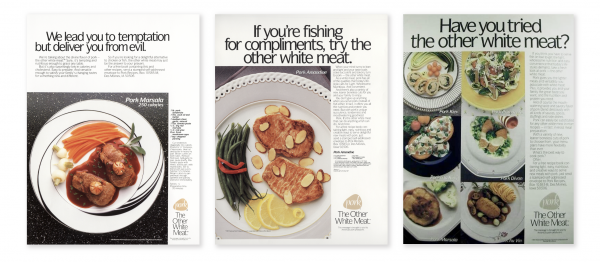Insights
In the mid-1980s, producers knew pork needed an extreme makeover to beat the legacy left over from the World War II era, when fat was valued as a premium with pork. Pork was generally viewed as a cheap protein source and an unsophisticated product. Consumers believed pork was fatty, high in calories and, in general, bad for you. And to add insult to injury, urban legend had it that pork needed to be cooked to the consistency of shoe leather for fear of trichinosis. “Lean” had become the buzzword of the day, and chicken was quickly becoming the meat of choice for millions of consumers.
Execution
Bozell was hired and the agency began researching the facts about chicken and fresh pork and found that the nutritional profiles of the two meats were much more similar than anyone had believed. Thanks to the era’s leaner hogs, pork had become a versatile, healthy source of protein. Nonetheless, pork still suffered from a severe consumer perception problem.
We created “Pork. The Other White Meat.” campaign as a competitive positioning platform, and then developed provocative print and television advertisements with messages such as, “We lead you to temptation but deliver you from evil,” to help pork compete head-to-head with chicken.

Our intent was to stop people in their tracks and then explain how pork could be a white meat, since most considered it a red meat. To show that pork was as easy to prepare as chicken and was even more versatile, Bozell took 40 poultry recipes like chicken cordon bleu and transformed them into pork-based entrees that were featured in the advertising campaign.
Results
After 10 weeks of ads in target cities, the number of people who thought of pork as white meat jumped from 12 percent to 72 percent. Within a few years, “Pork. The Other White Meat.” had become the fifth most recognized advertising slogan in America. And the pork industry grew substantially for decades following the launch of the campaign. The retail value of pork grew steadily, outpacing the rate of inflation. Production increased 37 percent. U.S. per capita consumption climbed from 51.5 pounds to 53.4 pounds a year and the U.S. has changed from being an importer of pork to being a net exporter of pork products.



